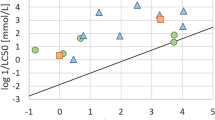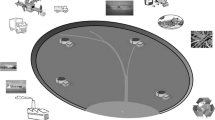Abstract
Background, aim and scope
Due to a number of drawbacks associated with the previous regime for the assessment of new and existing chemicals, the European Union established a new regulation concerning the registration, evaluation, authorisation and restriction of chemicals (REACH). All relevant industrial chemicals must now be assessed. Instead of the authorities, industry itself is responsible for the risk assessment. To achieve better and more efficient assessments while reducing animal testing, all information—standard, non-standard and non-testing—has to be used in an integrated manner. To meet these challenges, the current technical guidance documents for risk assessment of new and existing chemicals had to be updated and extended considerably. This was done by experts in a number of REACH Implementation Projects. This paper presents the most relevant results of the expert Endpoint Working Group on Aquatic Toxicity in order to illustrate the change of paradigm in the future assessment of hazards to the aquatic environment by chemical substances.
Main features and challenges
REACH sets certain minimum data requirements in order to achieve a high level of protection for human health and the environment. It encourages the assessor to use alternative information instead of or in addition to standard one. This information has to be equivalent to the standard information requirement and adequate to draw overall conclusions with respect to the regulatory endpoints classification and labelling, persistent, bioaccumulative and toxic (PBT) assessment and predicted no-effect concentrations (PNEC) derivation. The main task of the expert working group was to develop guidance on how to evaluate the toxicity of a substance based on integration of information from different sources and of various degrees of uncertainty in a weight of evidence approach.
Integrated testing and intelligent assessment
In order to verify the equivalence and adequacy of different types of information, a flexible sequence of steps was proposed, covering characterisation of the substance, analysis of modes of action, identification of possible analogues, evaluation of existing in vivo and in vitro testing data as well as of QSAR results. Finally, all available data from the different steps have to be integrated to come to an overall conclusion on the toxicity of the substance. This weight of evidence approach is the basis for the development of integrated testing strategies (ITS), in that the available evidence can help to determine subsequent testing steps and is essential for an optimal assessment. Its flexibility helps to meet the different requirements for drawing conclusions on the endpoints classification and labelling, PNEC derivation as well as PBT assessment. The integration of all kinds of additional information in a multi-criteria assessment reduces the uncertainties involved with extrapolation to the ecosystem level. The weight of evidence approach is illustrated by practical examples.
Conclusions and perspectives
REACH leads to higher challenges in order to make sound decisions with fewer resources, i.e. to move away from extensive standard testing to an intelligent substance-tailored approach. Expert judgement and integrated thinking are key elements of the weight of evidence concept and ITS, potentially leading to better risk assessments. Important sub-lethal effects such as endocrine disruption, which are not covered by the current procedure, can be considered. Conclusions have to be fully substantiated: Risk communication will be an important aspect of future assessments.

Similar content being viewed by others
References
Ahlers J, Riedhammer C, Vogliano M, Ebert R-U, Kühne R, Schüürmann G (2006) Acute to chronic ratios in aquatic toxicity—variation across trophic levels and relationship with chemical structure. Environ Toxicol Chem 25:2937–2945
Bodar CWM, Berthault F, de Bruijn JHM, van Leeuwen CJ, Pronk MEJ, Vermeire TG (2003) Evaluation of EU risk assessments existing chemicals ((EC Regulation 793/93). Chemosphere 53:1039–1047
Breitholtz M, Ruden C, Hansson SO, Bengtsson B-E (2006) Ten challenges for improved ecotoxicological testing in environmental assessment. Ecotoxicol Environ Saf 63:324–335
Devillers J, Marchand-Geneste N, Carpy A, Porcher JM (2006) SAR and QSAR modeling of endocrine disruptors. SAR QSAR Environ Res 17:393–412
EC (1993) Council Regulation 793/93/EEC on the evaluation and control of risks of existing substances. Official Journal of the European Communities L161
ECB (2008) Toxtree. http://ecb.jrc.it/qsar/qsar-tools/index.php?c=TOXTREE
ECETOC (2005) Alternative testing approaches in environmental safety assessment. European Centre for Ecotoxicology and Toxicology of Chemicals, Brussels Technical Report No. 97
ECHA (2008a) Guidance on information requirements and chemical safety assessment. European Chemicals Agency 2008, http://reach.jrc.it/docs/guidance_document/information_requirements_r7b_en.pdf?vers=30_07_08
ECHA (2008b) Guidance on information requirements and chemical safety assessment. European Chemicals Agency 2008, http://reach.jrc.it/docs/guidance_document/information_requirements_r6_en.pdf?vers=30_07_08
Jeram S, Riego Sintes JM, Halder M, Baraibar Fentanes J, Sokull-Klüttgen B, Hutchinson TH (2005) A strategy to reduce the use of fish in acute ecotoxicity testing of new chemical substances notified in the European Union. Regul Toxicol Pharmacol 42:218–224
Laws SC, Yavanhxay S, Cooper RL, Eldridge JC (2006) Nature of the binding interaction for 50 structurally diverse chemicals with rat estrogen receptors. Toxicol Sci 94:46–56
OECD (2002a) Detailed review paper: Appraisal of test methods for sex hormone disrupting chemicals. Series on testing and assessment No. 21, http://appli1.oecd.org/olis/2002doc.nsf/linkto/env-jm-mono(2002)8
OECD (2002b) Draft detailed review paper: Steroidogenesis (under revision). http://www.oecd.org/dataoecd/53/48/33689020.pdf
OECD (2008) OECD Structure-Activity Relationships Project. http://www.oecd.org/document/23/0,3343,en_2649_34365_33957015_1_1_1_1,00.html
Saliner AG, Netzeva TI, Worth AP (2006) Prediction of estrogenicity: validation of a classification model. SAR QSAR Environ Res 17(2):195–223
Tong W, Fang H, Hong H, Xie Q, Perkins R, Anson J, Sheehan DM (2003) Regulatory applications of SAR/QSAR for priority setting of endocrine disruptors: a perspective. Pure Appl Chem 75(11–12):2375–2388
Verhaar HJM, Van Leeuwen CJ, Hermens JLM (1992) Classifying environmental pollutants. 1: structure-activity relationships for prediction of aquatic toxicity. Chemosphere 25:471–491
Von der Ohe PC, Kühne R, Ebert R-U, Altenburger R, Liess M, Schüürmann G (2005) Structural alerts—a new classification model to discriminate excess toxicity from narcotic effect levels of organic compounds in the acute Daphnid assay. Chem Res Toxicol 18:536–555
Acknowledgement
We thank the members of RIP 3.3-2, EWG 8: Alicja Andersson, Ian Doyle, Steve Dungey, Anne Gourmelon, Marlies Halder, Geoff Hodges, Flemming Ingerslev, Tatiana I. Netzeva, Caroline Riedhammer, Diederik Schowanek, Hans-Christian Stolzenberg, Paul Thomas and Marnix Vangheluwe.
Author information
Authors and Affiliations
Corresponding author
Rights and permissions
About this article
Cite this article
Ahlers, J., Stock, F. & Werschkun, B. Integrated testing and intelligent assessment—new challenges under REACH. Environ Sci Pollut Res 15, 565–572 (2008). https://doi.org/10.1007/s11356-008-0043-y
Received:
Accepted:
Published:
Issue Date:
DOI: https://doi.org/10.1007/s11356-008-0043-y




